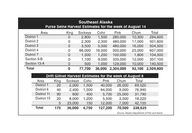Sorted by date Results 126 - 150 of 464

The Alaska Chamber of Commerce touts itself as "the voice of Alaska business" but seafood industry and coastal community members are largely left out of the conversation. The Chamber isn't entirely at fault; it appears that most of those members are not speaking up. Three cases in point. In February the Chamber was one of the first to "applaud Governor Dunleavy for proposing a spending plan that matches current revenues." In April the Chamber testified in support of the Pebble Mine draft...
It’s been one year, so how’s that trade war with China working out for the nation’s seafood industry? As with farmers, there’s not much winning and ongoing tweeted skirmishes have global fish markets skittish. The quick take is the 25 percent retaliatory tariff imposed by China on US imports last July caused a 36 percent drop in US seafood sales, valued at $340 million, according to an in-depth analysis of Chinese customs data by Undercurrent News. “Chinese imports of US seafood fell from $1.3 billion in the 12 months prior to tariffs (...

As Alaska lawmakers continue their struggle to keep the state afloat, commercial fisheries dodged a bullet that would have removed millions of dollars from its budget. An obscure procedural action within the capital budget called a 'reverse sweep' prevents dozens of program-specific pots of money from being automatically drained into the budget reserve, as Governor Dunleavy aimed to do. "The sweep is money that is not spent in a single year. In this case, it comes from certain sources, such as...
Fisheries fare better than most people in terms of Governor Mike Dunleavy’s budget cuts. Just under one million dollars was cut from the commercial fisheries division of the Alaska Department of Fish and Game, leaving it with an $85 million budget, half from state general funds. “To give the governor credit, he recognized the return on investment,” said Doug Vincent-Lang, ADF&G Commissioner. “It’s a theme I had all the way through the legislature that we take a $200 million budget of which about $50 million is unrestricted general funds and...
One fisheries item that appears to have escaped Governor Mike Dunleavy’s veto pen so far is his desire to divert local fish taxes from coastal communities into state coffers. Dunleavy’s initial budget in February aimed to repeal the sharing of fisheries business and landing taxes that towns and boroughs split 50/50 with the state. Instead, all of the tax revenues would go to the state’s general fund – a loss of $28 million in FY 2020 to fishing communities. “There is a recognition that these are viewed as shared resources, and they should be...
The biggest fish story for Alaska’s salmon season so far is the early plug of pinks at the South Alaska Peninsula. By June 28, over 8 million pink salmon were taken there out of a statewide catch of just over 8.5 million. Previously, a catch of 2.5 million pinks at the South Peninsula in 2016 was the record for June and last year’s catch was just 1.7 million Managers at the Alaska Dept. of Fish and Game at Sand Point said at this pace, this month’s catch could near 10 million pinks. “It’s unheard of, really,” ADF&G’s Elisabeth Fox told KDLG...
A well-intended new Alaska law has gone awry from a botched roll out that has turned thousands of Alaskan fishing vessel, tender, barge and sport fish operators into lawbreakers. Since the start of 2019, all vessels over 24 feet are required to be registered with the State at a Department of Motor Vehicles office. Previously, vessels that were documented with the US Coast Guard were not also required to register with the state. The registration costs $24 and is good for three years. “You need to get down to the DMV whether you’re doc...
Salmon dominates the summer fishing headlines but it’s among many other fisheries going on throughout the Gulf of Alaska and Bering Sea. Alaska’s salmon season has gotten off to a mixed start, with strong catches in some regions over the past month and dismal hauls in others. Good harvests have continued at the Copper River and more recently throughout Prince William Sound. That’s not been the case at Kodiak, Cook Inlet and Chignik where fishing is off to a very slow start. Trollers are targeting Chinook salmon in Southeast, and other salmo...
Alaska fishermen are still awaiting disaster relief funds for the 2016 pink salmon run failure, which was the worst in 40 years. Congress approved $56 million that year for Alaska fishermen, processors and communities hurt by the fishery flop at three Alaska regions: Kodiak, Prince William Sound and Lower Cook Inlet. The Alaska Department of Fish and Game and NOAA Fisheries finalized plans and procedures for payouts last August. Since then, the paper push has stalled on various federal agency desks. NOAA Fisheries missed a promised June 1 sign...
Shrimp shines in the Panhandle - Southeast Alaska is the state’s biggest producer of America’s #1 seafood favorite: shrimp. And much of it is enjoyed right where it’s landed. Four varieties of shrimp are taken at various times throughout the year by permit holders, with recent catches topping 1.5 million pounds, worth $3 million at the docks. “We have 19 different areas around Southeast and each has its own appropriate harvest level for sustainability,” said Dave Harris, area manager for the Alaska Department of Fish and Game in Juneau. C...
Salmon abundance in the North Pacific has declined slightly over the past decade, but salmon catches remain near all-time highs. For nearly 30 years the North Pacific Anadromous Fish Commission (NPAFC) has summarized abundances and catches of salmon as reported by its five member countries - Canada, Japan, Korea, Russia, and the U.S. The Commission tracks all salmon species caught in the North Pacific, Bering Sea and the Sea of Okhotsk, and also provides the venue for coordinating research and enforcement activities. For 2018, the total salmon...
In his 46 years as Alaska’s lone representative in Congress, Don Young helped toss out foreign fishing fleets from Alaska’s waters with the onset of the Magnuson-Stevens Fishery Conservation and Management Act (MSA) in 1976, and today he is intent on doing the same with offshore fish farms. The MSA established an ‘exclusive economic zone’ (EEZ) for U.S. fleets fishing from three to 200 miles from shore. Now, a bill introduced by Young aims to stop the Trump Administration’s push to use those waters for industrialized fish farming operation...
Bering Sea crabbers saw upticks in crab recruits during a good fishery for the 2018/2019 season, along with strong prices. The crab season opens in mid-October for red king crab, Tanners and snow crab (opilio), and while fishing goes fast for red kings in order to fill orders for year-end markets in Japan, the fleet typically drops pots for the other species in January. Crabbers said they saw strong showings of younger crab poised to enter the three fisheries. Only male crabs of a certain size are able to be retained for sale. “For Bristol Bay...
Bulldozers, blasters, excavators, vibrators, jaw crushers, drillers, graders, crushers, huge trucks and other heavy equipment are tools of the trade when building and operating large mines - and they all kick up a lot of dust. In the case of the Pebble Mine, the project is expected to generate 8,300 tons of so called fugitive dust in its annual mining operations. Another 5,700 tons will come from building the 83 mile main road to Cook Inlet, and the 35 daily round trip trucking of mineral concentrates will churn out 1,500 tons of road dust...
Why should every Alaskan budget watcher care about the price of fish? Because when the price at the docks goes up by just one penny, it means more money for state coffers. In 2017, for example, the average dock price per pound for all Alaska seafood was 41 cents. If the price had increased to 42-cents, it would have added nearly $2 million more from fisheries landing and business taxes. That was one of the takeaways in an updated McDowell Group report presented last week at the Alaska Seafood Marketing Institute’s spring board meeting. It o...
Nearly all Alaska salmon permits have gone up in value since last fall and buying/selling/trading action is brisk. “We’re as busy as we’ve ever been in the last 20 years,” said Doug Bowen of Alaska Boats and Permits in Homer. “Boat sales are doing well and between IFQs and permit sales, we’ve got a busy year going.” The salmon permit interest is fueled by a forecast this year of over 213 million fish, an 85 percent increase over 2018. Also, salmon prices are expected to be higher. For the bellwether drift permit at Bristol Bay, the value has in...
The Panhandle plans to be the next Alaska region to give new life to old fishing gear by sending it to plastic recycling centers. The tons of nets and lines piled up in local lots and landfills will become the raw material for soda bottles, cell phone cases, sunglasses, skateboards, swimsuits and more. Juneau, Haines, Petersburg and possibly Sitka have partnered with Net Your Problem to launch an effort this year to send old or derelict seine and gillnets to a recycler in Richmond, British Columbia. “We’re going to be working in a new loc...
Alaska fishermen could catch 85 percent more salmon this year (nearly a hundred million more) if state forecasts hold true. That’s good news for fishermen in many Gulf of Alaska regions who in 2018 suffered some of the worst catches in 50 years. The Alaska Dept. of Fish and Game is predicting a total salmon catch of 213.2 million fish for 2019, compared to about 116 million salmon last year. The increase comes from expectations of another big haul of sockeyes, increases in pinks and a possible record catch of chum salmon. The harvest b...

None of the members of the Senate Community and Regional Affairs committee (CRA) lives near the sea, but at a hearing last week they were not impressed by Governor Dunleavy's plan to pull millions of dollars in fish taxes from remote coastal towns. Bills submitted to the legislature by the governor would remove the ability of towns to keep their share of local fisheries business and landing taxes. For decades, the taxes have been split 50/50 with the state. Dunleavy wants to take all of the...
Commercial fishermen pick up the tab for just about anyone who catches a salmon in Alaska that started its life in a hatchery. That was a finding that wended its way to the surface during a hearing last week of the House Fisheries Committee on the state’s hatchery program. The program began in the mid-1970s to enhance Alaska’s wild salmon runs. Unlike meetings that are top heavy with fishery stakeholders, most of the committee members are not deeply familiar with many industry inner workings and their interest was evident. “Who funds the hatch...
”A new lender is offering loans to young Alaska fishermen who want to buy into the halibut and sablefish fisheries, and repayment is based on their catches. The Local Fish Fund opened its doors this month to provide alternative loan structures to young fishermen as a way to help turn the tide on the trend called the “graying of the fleet.” The average age of an Alaska fisherman today is 50 and fewer recruits are choosing the fishing life. A big part of what’s turning them away is the cost to buy into fisheries that are limited through permits...
So how’s that trade war with China going? Up until last July, when the Trump Administration slapped a 25 percent tax on nearly all U.S. seafood imports from China, that country was Alaska’s biggest trading partner for seven years running. In 2017, China bought 54 percent of Alaska’s fish and shellfish products, valued at $800 million. That tax volley was followed by a retaliatory 10 percent tariff from China in September that included U.S. exports. U.S. tariffs against $200 billion worth of Chinese imports were set to increase to 25 perce...

Push that pasta aside. Noodles made from Alaska pollock are poised to become a center of the plate favorite. Alaska Pollock Protein Noodles from Trident Seafoods swept the awards at the 26th annual Alaska Symphony of Seafood new products competition in Juneau. The low carb, "flavor neutral" noodles contain 1O grams of protein per serving and can be swapped with any pasta favorites. The ready to eat item drew raves from judges and samplers from Seattle to Southeast who gave the noodles quadruple...
Alaska’s new slogan is “open for business” but good luck trying to find out any budget details when it comes to the business of fishing. The Dunleavy administration has a full gag order in place at the Alaska Department of Fish and Game and all budget questions, no matter how basic, are referred to press secretary Matt Shuckerow. Likewise, queries to the many deputies and assistants at the ADF&G commissioner’s office are deferred to Shuckerow who did not acknowledge messages for information. “It isn’t just the media or Alaskans. Legislators...
Small electronic beacons that are being widely used by increasing numbers of fishermen could net them big fines. Automatic Identification Systems (AIS) are easily attached to nets, longlines and pots and signal the locations of the gear via a vessel’s navigation system, laptops, even cell phones. The inexpensive buoys, which range from $47 to $199 from most online retailers, are regarded as a God send by fishermen in the way they help locate gear as well as being a potential money saver. “If you’re not sitting on your gear with your vesse...